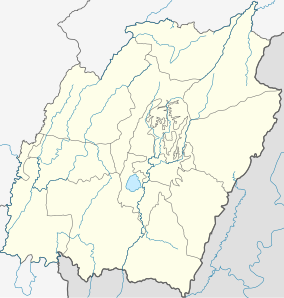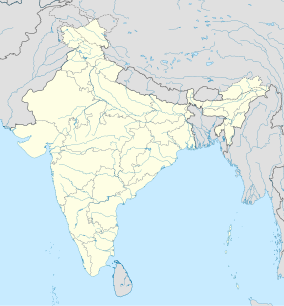
Back কেবুল লামজো জাতীয় উদ্যান Bengali/Bangla Parc Nacional de Keibul Lamjao Catalan Keibul-Lamjao-Nationalpark German Parque nacional de Keibul Lamjao Spanish Parc national de Keibul Lamjao French केयबुल लामजाओ राष्ट्रीय उद्यान Hindi Parco nazionale di Keibul Lamjao Italian ಕೈಬುಲ್ ಲಂಜಾವ್ ರಾಷ್ಟ್ರೀಯ ಉದ್ಯಾನ Kannada Keibul Lamdžao nacionalinis parkas Lithuanian കിബുൾ ലംജാവോ ദേശീയോദ്യാനം Malayalam
| Keibul Lamjao National Park | |
|---|---|
 Endangered Sangai deer (Cervus eldi eldi) | |
| Location | Bishnupur District, Manipur, India |
| Nearest city | Moirang, Imphal |
| Coordinates | 24°30′00″N 93°46′00″E / 24.50000°N 93.76667°E |
| Area | 40 km2 (15 sq mi) |
| Established | 28 March 1977 |
| Governing body | Government of India, Government of Manipur |
| web | |
The Keibul Lamjao National Park (Meitei: Keibul Lamjao Leipakki Lampak) is a national park in the Bishnupur district of the state of Manipur in Northeast India. It is 40 km2 (15.4 sq mi) in area, the only floating national park in the world, and an integral part of Loktak Lake.[1][2] It is currently under the tentative lists of the UNESCO World Heritage Sites, under the title "Keibul Lamjao Conservation Area (KLCA)", additionally covering the buffer of Loktak Lake (140 sq km) and Pumlen Pat (43 sq. km).[3][4]
The national park is characterized by floating decomposed plant material locally called phumdi. It was created in 1966 as a wildlife sanctuary to preserve the natural habitat of the endangered Eld's deer (Cervus eldi eldi). In 1977, it was gazetted as national park.[5][6]
- ^ "The Floating Islands of India". earthobservatory.nasa.gov. 7 May 2018. Archived from the original on 13 March 2023. Retrieved 13 March 2023.
The largest island is home to the Keibul Lamjao, the world's only floating national park. It serves as a habitat for the endangered brow-antlered sangai, or "dancing deer," whose hooves have adapted to the island's spongy ground. The park, covering 15 square miles (40 km2), was specifically created to preserve the deer, which were once thought to be extinct.
- ^ McKechnie, Ben. "The world's only floating national park". www.bbc.com. Archived from the original on 13 March 2023. Retrieved 13 March 2023.
- ^ Centre, UNESCO World Heritage. "Keibul Lamjao Conservation Area". UNESCO World Heritage Centre. Archived from the original on 15 July 2017. Retrieved 13 March 2023.
- ^ "Keibul Lamjao Conservation Area | For UNESCO World Heritage Travellers". www.worldheritagesite.org. Archived from the original on 30 November 2022. Retrieved 13 March 2023.
- ^ "Keibul Lamjao National Park Forest Department, Government of Manipur". Archived from the original on 15 October 2008. Retrieved 9 January 2009.
- ^ Wemmer, Christen M.; Moore, Donald; Blouch, Raleigh (1998). Deer: status survey and conservation action plan. IUCN. p. 69. ISBN 2-8317-0454-5. Retrieved 29 March 2009.[permanent dead link]
© MMXXIII Rich X Search. We shall prevail. All rights reserved. Rich X Search

